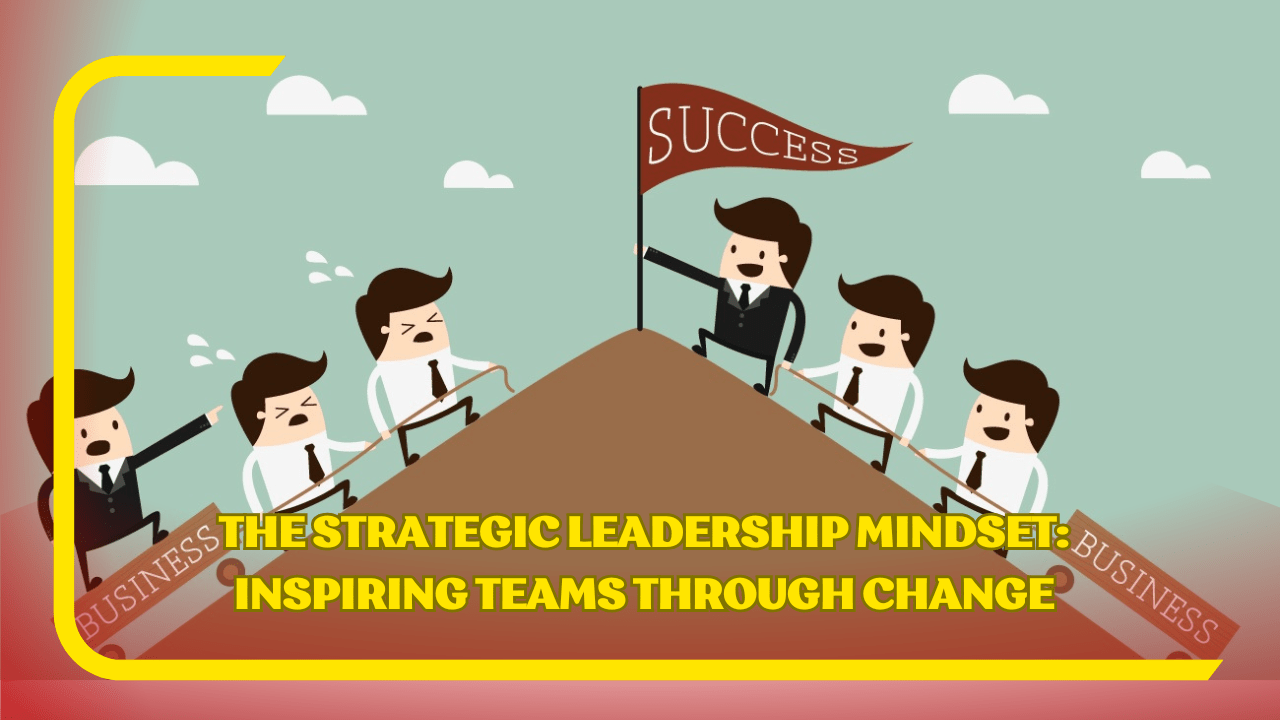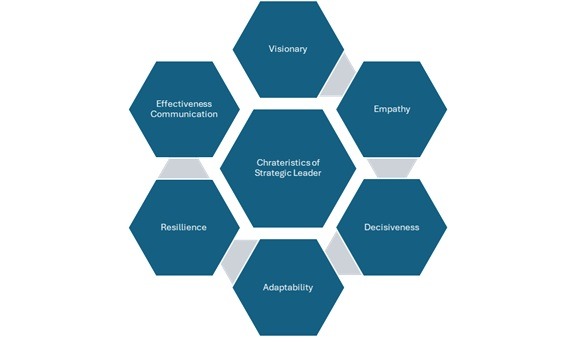The Strategic Leadership Mindset: Inspiring Teams Through Change

THE STRATEGIC LEADERSHIP MINDSET: INSPIRING TEAMS THROUGH CHANGE
Who is a strategic leader and their main characteristics:
A strategic leader is someone who provides guidance and vision, aligning the organization’s goals with its long-term success. They are responsible for defining the direction of an organization, making high-level decisions, and ensuring that all parts of the organization are working together to achieve those objectives. Unlike operational or managerial leaders, who focus on short-term goals and day-to-day management, strategic leaders are forward-thinking, continuously assessing the internal and external environments to steer the organization toward future success.
Strategic leadership requires a deep understanding of both the organization and the broader market or industry in which it operates. A strategic leader must consider long-term trends, potential disruptions, competitive landscapes, and emerging opportunities. They are adept at reading and interpreting complex information, balancing both current needs and future possibilities. A key part of their role is to help the organization adapt to change, manage risk, and anticipate challenges before they arise.
Let’s look at the key characteristics of a strategic leader:

Visionary: A strategic leader has a clear, long-term vision for the organization and guides the team toward achieving that vision, helping to set goals and align efforts.
Empathy: They understand and care about the well-being of their team, actively listening to their concerns and fostering a supportive, inclusive work environment.
Effective Communication: Strategic leaders convey information clearly and consistently, ensuring all team members are aligned with the organization’s goals and expectations.
Decisiveness: They make informed decisions quickly, even in uncertain situations, providing direction and clarity for their teams.
Adaptability: They embrace change and remain flexible, adjusting strategies when necessary to navigate shifting market conditions or unexpected challenges.
Resilience: Strategic leaders are able to remain focused and composed during tough times, inspiring their teams to persevere and stay motivated despite obstacles.
How strategic leadership inspire teams through change in an organisation
Strategic leadership plays a vital role in guiding teams through change by providing a clear vision and direction. Leaders help employees understand the purpose behind the change, ensuring alignment with organizational goals. This transparency reduces uncertainty and fosters a sense of purpose among team members. By communicating the “why” of change and making sure teams understand how it aligns with the larger strategy, strategic leaders can motivate employees and inspire commitment. Additionally, empowering team members by involving them in decision-making and encouraging feedback builds a sense of ownership and connection to the change process, making employees more likely to support and embrace the transformation.
Moreover, strategic leaders inspire teams by building trust, adapting to challenges, and providing continuous support. Through open and honest communication, leaders can keep employees informed, alleviate concerns, and maintain morale. Leading by example, showing resilience in the face of adversity, and remaining flexible in response to setbacks strengthens the team’s ability to adapt. Additionally, by ensuring that employees have the necessary resources and training, strategic leaders help reduce anxiety and foster a confident, empowered workforce. Celebrating small successes throughout the change process reinforces progress and boosts motivation, while demonstrating that the effort is valued. In these ways, strategic leadership inspires teams to stay focused, motivated, and engaged through periods of change.
Driving teams in an organization to adapt to change requires a strategic approach that ensures alignment, engagement, and sustained support throughout the process. Below is a step-by-step method for guiding teams through change effectively:
- Establish a Clear Vision: Start by communicating the purpose of the change. Explain why the change is necessary and how it aligns with the organization’s long-term goals. This helps create a sense of purpose, giving employees clarity and motivation to embrace the change.
- Involve Key Stakeholders Early: Identify influential team members and involve them early in the planning process. This helps generate buy-in and creates advocates who can influence their peers positively. By involving employees in decision-making, you make them feel invested in the success of the change.
- Create a Communication Plan: Regular and transparent communication is essential. Develop a plan to communicate key updates, address concerns, and provide feedback channels. Frequent updates on progress, both positive and negative, ensure employees feel informed and included.
- Provide Training and Resources: Ensure that teams are equipped with the necessary skills, tools, and resources to succeed in the new environment. Offer training programs, workshops, and mentorship to help employees adapt and feel more confident in handling new responsibilities.
- Lead by Example: Demonstrate the behaviors and attitudes you expect from the team. Leaders who embrace change and exhibit flexibility set a powerful example for others. Leading with confidence and a positive mindset helps inspire others to do the same.
- Monitor Progress and Offer Support: Regularly assess how well teams are adjusting to the change. Identify challenges and offer support as needed. Provide additional resources or guidance to help overcome obstacles.
- Celebrate Successes: Acknowledge and celebrate milestones, even small ones. Recognizing achievements boosts morale and reinforces the positive aspects of the change process, helping to build momentum and motivation.
By following these steps, organizations can successfully guide teams through change, ensuring a smooth transition and fostering a culture of adaptability and growth.
Let’s look at real life case studies how strategic leadership has supports teams effectively through change in some of the prominent organisations:
| Satya Nadella’s Leadership at Microsoft | |
| When Satya Nadella became the CEO of Microsoft in 2014, the company was struggling with innovation and adapting to a changing tech landscape, especially as it faced stiff competition from companies like Google and Apple. Microsoft’s culture was also seen as rigid and siloed, hindering collaboration and agility. | |
|
Strategic Leadership Actions:
|
|
|
Results: Under Nadella’s leadership, Microsoft successfully pivoted to become a leading cloud provider, with Azure experiencing substantial growth. The cultural transformation improved employee engagement and productivity, resulting in an increase in Microsoft’s stock price and market value. Nadella’s ability to lead through a strategic vision and cultural change helped Microsoft remain competitive in a rapidly evolving industry. |
|
| Howard Schultz and the Transformation of Starbucks | |
| In the early 2000s, Starbucks was facing stagnation. The company’s rapid expansion had diluted its brand, and the customer experience was suffering. In 2008, when Howard Schultz returned as CEO, the company was on the brink of losing its position as a leader in the coffeehouse industry | |
|
Strategic Leadership Actions:
|
|
|
Results: Starbucks’ revival under Schultz’s leadership was marked by increased profitability, improved customer experience, and reinvigorated brand loyalty.The company saw strong growth in both retail and digital offerings, with its mobile app becoming a key driver of sales. Schultz’s focus on both operational changes and cultural values successfully steered Starbucks through a critical transformation period |
|
| Alan Mulally’s Turnaround of Ford Motor Company | |
| In 2006, Ford was facing a financial crisis and was at risk of becoming irrelevant in the auto industry. The company had suffered from declining market share, inefficient operations, and a fragmented product lineup. Many predicted Ford’s failure, especially amid the broader challenges in the U.S. automotive sector | |
|
Strategic Leadership Actions:
|
|
|
Results: Ford was the only major U.S. automaker to avoid bankruptcy during the 2008 financial crisis, thanks to Mulally’s strategic leadership. The company’s transformation included a renewed product lineup that included successful models like the Ford Fusion and Ford Focus, contributing to profitability and market share growth. Mulally’s leadership restored Ford’s financial health and reputation, proving that a clear vision, decisive actions, and strong communication could lead an organization through substantial change |
|
Let’s us share the insights from strategic leadership perspective of some of our own clients:
Lean Partner’s collaboration with one of Malaysia’s largest healthcare groups in deploying Lean Six Sigma Green Belt projects across their hospitals has led to significant operational improvements. Through effective group-level execution and monitoring, we achieved an impressive 80% project closure rate on time, while also delivering a 20% average reduction in Turnaround Time (TAT) for both admission and discharge processes. Additionally, our efforts resulted in a 10% reduction in patient leakages, driving better patient flow, enhanced service delivery, and a more efficient healthcare experience overall. This successful implementation highlights the group’s ability in driving the project teams to execute change through strategic leadership.
Lean Partner’s work with a shared service supporting Malaysia’s leading energy provider has yielded remarkable results through the successful deployment of Six Sigma training and project execution. With robust backing from their process owners, the initiative led to a 20% improvement in end-to-end process Turnaround Time (TAT) and a 15% increase in customer satisfaction scores. These outcomes demonstrate the effectiveness of strategic leadership at the management level, driving operational excellence and a customer-centric approach. The successful execution of these projects underscores the power of collaboration, continuous improvement, and strong leadership in achieving sustainable business transformation.
Conclusion
Strategic leadership plays a pivotal role in inspiring teams through change, as it provides a clear vision, fosters trust, and empowers individuals to embrace transformation. By leading with empathy, effective communication, and resilience, strategic leaders not only guide their teams through uncertainty but also build a culture of adaptability and innovation. Their ability to align organizational goals with individual aspirations creates a sense of shared purpose, motivating employees to not only accept change but to actively contribute to its success. Ultimately, strategic leadership enables organizations to thrive in dynamic environments, ensuring long-term growth, operational excellence, and a strong, engaged workforce.
Take the first step towards harnessing the full potential of change. By joining us now, you’ll unlock the tools and insights needed to drive transformation and achieve lasting success. Embrace the future with confidence and adaptability.
